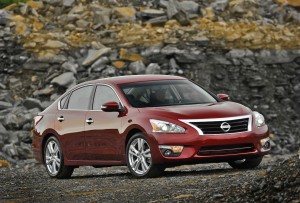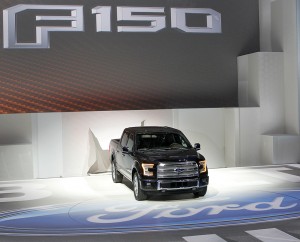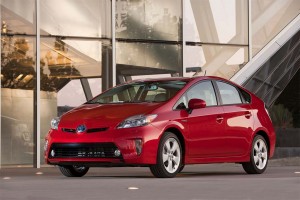
The Nissan Altima is one of a growing list of vehicles delivering better than 23 mpg - often more than 30 miles per gallon.
Despite the resurgence of full-size pickups, SUVs and muscle cars, American car buyers are getting better fuel economy than ever before, over half of the vehicles sold this year delivering over 23 mpg, according to a new study, with one in nine topping 30 mpg.
Even some traditional gas guzzlers are now yielding mileage once considered a stretch for small cars, industry and government data reveals, though automakers still face a stretch achieving the 54.5 mpg target facing them in 2025, observers warn.
“This has been remarkable,” said Mark Cooper, research director for the Consumer Federation of America, which has been tracking fuel economy trends for over a decade. After years of relatively stagnant mileage, the increased federal fuel economy rules passed in 2005 have been paying off, he said, calling it a “great example” of how industry can respond to mandates backed by public support.
CFA’s annual study found the percentage of vehicles getting at least 23 mpg hit a record 50.5% for the 2014 model-year, compared with just 19% in 2009. And 11.6% now top 30 mpg, a tenfold increase in just five years. Notably, there’s no longer a single model rated at less than 13 mpg.
The new CFA study is echoed in another report issued this month by the University of Michigan Transportation Research Institute which found that U.S. fuel economy is at its highest level ever. Vehicles sold in March of this year got an average 25.4 mpg, up 0.3 miles a gallon from February and a full 5.3 mpg from October 2007, when UMTRI began tracking fuel economy.
(For more on the UMTRI study, Click Here.)
“In a sense, this is capitalism at its best,” suggested CFA research director Cooper, suggesting that the auto industry needed “to be kicked in the butt a bit” to see the growing demand for high-mileage vehicles. Today, he stressed, it’s as much or more about consumer demand as it is federal regulations driving the rapid rise in fuel economy.
That said, the auto industry is under intense pressure to move even more quickly with a federal 35.5 mpg Corporate Average Fuel Economy standard taking effect in 2016 – CAFE jumping to 54.5 mpg by 2025.
Because of quirks in the regulations, manufacturers will be able to miss those numbers by about 10%, but will still be stretching to get there. Observers expect to see increased use of alternative fuels and propulsion systems, including battery power, hydrogen fuel-cells and diesels, as well as advanced gas engines, more efficient transmissions, improved aerodynamics and vehicle “lightweighting” and downsizing.
(New Trident Iceni Magna is the world’s fastest diesel sports car – and will deliver 2,000 miles a tank, maker claims. Click Here for the story.)
To underscore just how much the automotive market has shifted since CFA began tracking mileage in 2002, Cooper noted that there were only two new hybrids on the market at that point, the Toyota Prius and the original 2-seat Honda Insight. Though they collectively account for a modest 3% of the American market today, “every major manufacturer now is offering a hybrid across every product range.”
There are a growing number of pure battery-electric models and plug-in hybrids, as well. And high-mileage diesels are making a rapid comeback, Audi alone launching three for the 2014 model-year.

Ford's new F-150 will be up to 700 pounds lighter than the outgoing pickup truck. Photo credit: Len Katz.
Meanwhile, most makers have been migrating to smaller, turbocharged engines while also adopting newer high-gear transmissions, such as the 9-speed in the new Dodge Dart and Jeep Cherokee models from Fiat Chrysler.
And there’s a growing emphasis on cutting mass – lightweighting, in industry lingo. Ford Motor Co. will trim as much as 700 pounds off the weight of its various F-150 pickups for the 2015 model-year by switching from a traditional steel body to one made of aluminum. Though it is just a general rule of thumb, every 100 pounds of weight saved yields about 1 additional mpg.
There’s little doubt the mileage trend will continue, though many still question whether the industry can make the daunting 2025 fuel economy standard. The general consensus is that manufacturers will rapidly have to expand the use of hybrid power and even more advanced technologies, with some experts still not convinced 54.5 mpg is do-able.
“If we hold their feet to the fire they’ll find the technology,” insisted CFA’s Cooper. And countering those who question the potential price tag, he added that, “It’s a cost that has an immediate pocketbook benefit. The cost of efficiency is (offset) by the operating cost savings.”
(After a frigid winter, auto sales heating up in April. Click Here for the story.)


That’s a Helleva long ways from the absurd 54.5 mph mandated by the clueless Obama administration and the EPA.
Just to be clear, Jorge, this is not a measure of current US fleet average, which is higher. The latest UMTRI number is over 25 mpg for March. And because of the credits and adjustments to CAFE over the years, stated targets, ie 54.5 actually are much less in reality. The 2025 standard is actually more like a 48 mpg target, or less, especially with credits and “loopholes.”
Remember when the industry insisted it couldn’t come close to meeting the current CAFE and now admit they should blow through the 2016 interim target?
Paul E.
The reality is 90+ % of cars will never reach the 48 mpg let alone the absurd 54.5 mpg requirement by 2025. The credits are a ruse to dupe the public because the Feds and industry know it’s impossible to meet the absurd 54.5 mpg requirement pulled from the orifice of Obama and the EPA. This is irresponsible government defrauding the populace and it’s a disgrace.